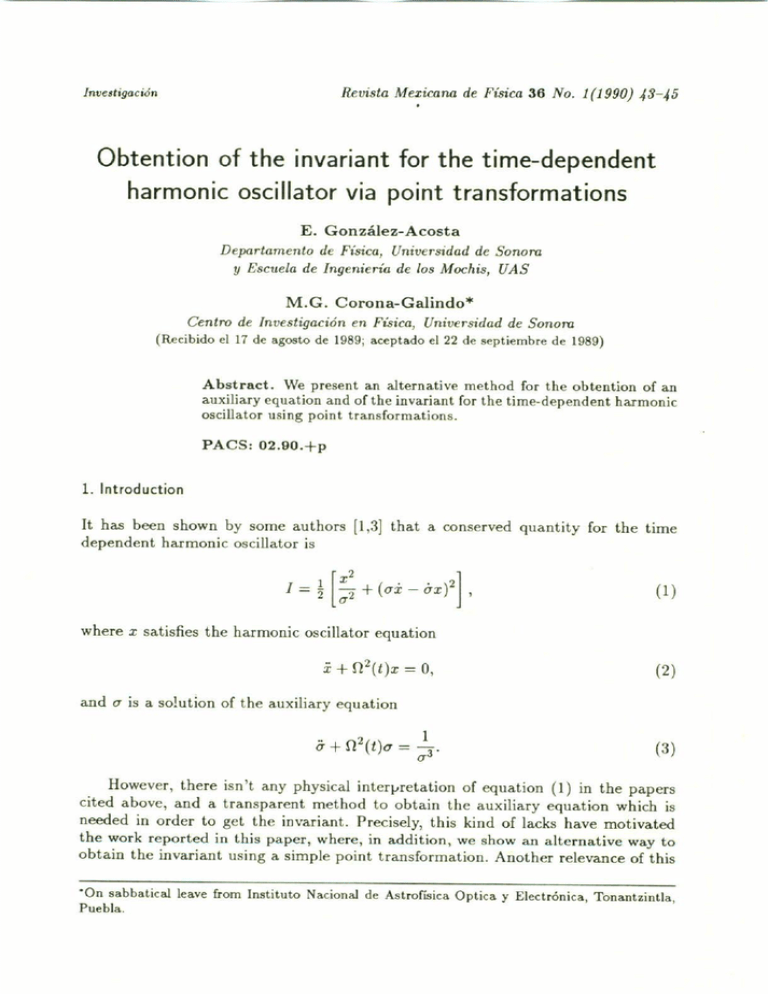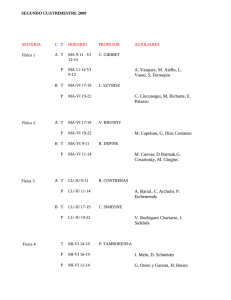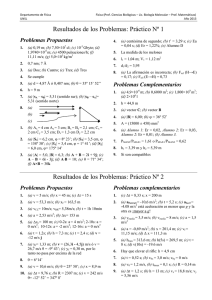Obtention of the invariant for the time
Anuncio

Revista Mexicana de Física 36 No. 1(1990) Invf:Jtigación -13--15 Obtention of the invariant for the time-dependent harmonic oscillator via point transformations E. González-Acosta Departamento de Física, Universidad de Sonora y Escuela de Ingeniería de los Mochis, UAS M.G. Corona.Galindo. Centro de Int:estigación en Física, Universidad de Sonora (Recibido el 17 de agosto de 1989; aceptado el 22 de ~ptiembre de 1989) Abstract. \Ve present an a1ternativc method for the obtention of an auxiliary equation and of the invariant for the time-dependent harmonic oscillator using point transformations. PACS: 02.90.+p 1. Introduction It has beco shown by sorne authors [I,3] that a oonscrved quantity for the time dependent harmonic oscillator is (1 ) where x satisfies the harmonic oscillator equation 1: + n2(t)x = O, (2) aod u is a so!ution of the auxiliary equation (3 ) However, there isn't any physical intcrpretation of equation (1) in the papers cited above, and a transparcnt method lo obtain lhe auxiliary equation which is nceded in order to get thc invariant. Precisely, this kind oC lacks have motivated the work reported in lhis paper, whcre, in addition, \Ve show an allcrnative way lo obtain the invariant using a simple poinl lransformation. Another rclevanee of this .On sabbatical ¡eave (rom Instituto Nacional de AstroflSica Optica y Electrónica, Tonantzintla, Puebla. 44 E. González-Acosta and M.G. Corona-Galindo work lies 00 the method proposed to obtain the auxiliary equation, whieh can be generalized to more eomplicated systerns. In Seetion 2 we obtain the invariant and the auxiliary equation. In Seetion 3 we diseuss the results. 2. Obtention of the auxiliary equation and the invariant We start with the well.knowo harmonie osciUator equation i: + O'(t)x (4 ) = O, where O(t) is the frequency with time dependence. Substituting the point transformation x = (5 ) <7(t)y, Eq. (4) hecomes 1" + O'(t)<7Jy + <7y + 2"11 = o. The varlable y can be eliminated (6) using Eq. (5) again, and multiplicatioo by (ux-ax) yields + O'(I)<7J + :t (<7X- "x)xl" C<7X ~ "X)') = o. (7) The right hand ter m of Eq. (7) is a total derivative and the whole expression will F(x,u) be an invariant if there is a funetion dF(x,<7) di = provided •. _ that , (<7X- <7x)x(<7 + O (1)<7) (8) is hold. This request is satisfied by the eonditions dF(x,<7) dt where ¡..t is a new variable for x/a. = dJJ/(.) di 1, A eonsequenee oC (9) (9) is that the Cunctions F(x,u) and /(1') must be related by F(x, (7) = ¡ r/. /(1') di" (10) Obtention 01 the inuariani lor the time.dependent Also, the following auxiliary equation ij harmonic oscillator... 45 must be satisfied + ¡¡'(I)a = f(xt). a x (11 ) Using Eqs. (8) and (9), one can find immediately the following form for the invariant 1 3. (oncluding = ~a' ')' + ¡XI" ( ~x i: - (12) f(ll) di" remarks Using only a point transformation [Eq. (5)] we have reproduced the results obtained by Ray and Reid [1,21 via other methods. If we substitute f(ll) = kll, with k an arbitrary constant, in Eq. (12), the invariant obtained by Lutzky [41 and Ray and Reid (1,2] follows immediatcly. Otherwise the auxiliary cquation in this work is a differential equation for the scale factor a(t), which makes pcrmissible the point transformation (5). In this context the invariant (12) contains the kinetic energy in mass units, potential energy also in mass units but affeded by a ncw frequency expressed by aja and related with O(t) via the auxiliary equation. The factor ¡:e/u J(¡.t) d¡.t appears as a compensation inflationary termo to thc potential energy and a2 as an References 1. 2. 3. 4. J.R. Ray and J.L. Reid, Phys. Lell. J.R. Ray and J.L. Reid, Phys. Lell. M. Lulzky, Phys. Lell. 7BA (1980) M. Lulzky, Phys. Lell. 6BA (1978) 7lA (1979) 317. 74A (1979) 23. 301. 3. Resumen. Se presenta un método alternativo para la obtención de la ecuación auxiliar y del invariante de un oscilador armónico dependiente del tiempo, usando transformaciones puntuales.



